News
Fall 2014 Release of Mediathread Supports Secure Collections
Mediathread is CCNMTL's innovative platform that supports multimedia analysis and annotation. With its latest release, Mediathread now supports media on secure websites (https) expanding the media collections that can be used within the tool, and allowing us to continue supporting recently secured applications such as YouTube and Flickr.
In addition to performance improvements, bookmarklet enhancements and an upgrade of the underlying Django framework, the Mediathread team introduced a new infinite scrolling feature that will make finding media within the tool much easier.
Finally, faculty can now request new classes directly from the website. For more information, and instructions on how to request a course in Mediathread see: Request a Mediathread Course
In addition to supporting faculty innovation at Columbia University, the Mediathread team continues to advance our partnership with Dartmouth's Media Ecology Project, and has expanded our user base to 4 continents.
New uses of the tool also were highlighted at CCNMTL's May 2014 symposium, Moving Images and the (Digital) Humanities, held at Teachers College and involving faculty and administrators from universities, museums, and other educational institutions.
CCNMTL Joins Silicon Alley at NYEdTech Startup Showcase 2014
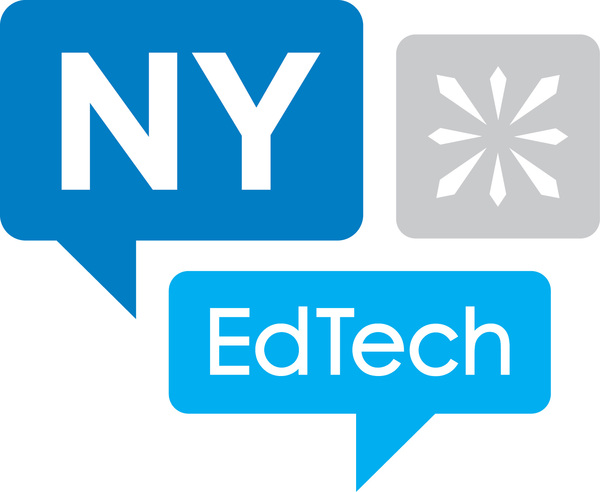 Mediathread, the open source multimedia annotation platform developed at the Columbia Center for New Media Teaching and Learning (CCNMTL), will be featured at the NYEdTech Startup Showcase 2014 on March 18. The event is organized by the NYEdTech Meetup and will let attendees “see the [edtech] community demonstrate how they’re solving some of education’s challenges with innovative and scalable technologies.”
Mediathread, the open source multimedia annotation platform developed at the Columbia Center for New Media Teaching and Learning (CCNMTL), will be featured at the NYEdTech Startup Showcase 2014 on March 18. The event is organized by the NYEdTech Meetup and will let attendees “see the [edtech] community demonstrate how they’re solving some of education’s challenges with innovative and scalable technologies.”
Adrienne Garber and Paul Stengel, both educational technologists at CCNMTL, will present Mediathread at the showcase alongside NYC-based tech companies Credly, MakerState, MarcoPolo, and Pear Deck.
The NYEdTech Startup Showcase 2014 will take place at Knewton’s Manhattan offices. Registration for the event is full, but individuals can request to be added to a waitlist.
The Spring 2014 Release of Mediathread is Live at Columbia
A new version of Mediathread, the open-source multimedia annotation tool developed by the Columbia Center for New Media Teaching and Learning, is now live and in use at Columbia University.
Highlights of the Spring 2014 Mediathread release include:
- Bookmarklet: The Mediathread bookmarklet experience has been redesigned to make collecting media more intuitive. Bookmarklet users can now import multiple items at once from compatible websites (such as YouTube, Flickr, ARTStor, and many others) into their Mediathread collection. Users can also now "send and stay"—that is, send items to a Mediathread collection without leaving an external website.
- Items: Users can edit the title of items they have brought items into Mediathread, via bookmarklet import or direct upload.
- Projects: Compositions now auto-save as a user edits them, ensuring no lost work.
- New code supports ARTStor's new dynamic URL creation.
- Login page redesigned to support multiple resolutions.
In Fall 2013, 65 classes at Columbia undertook learning activities in Mediathread, in subject domains including Art History, Education, Social Work, East Asian Studies, Music, Public Speaking, and Reading and Composition. Mediathread is now also in use at several other higher education institutions.
The updated code is publicly available at GitHub. For more information about Mediathread and uses of it at Columbia University, visit CCNMTL's website.
Mediathread Presented at Digital Content Workshop in Philadelphia
On June 21, Columbia Center for New Media Teaching and Learning (CCNMTL) staff members Jonah Bossewitch and Tucker Harding presented Mediathread in Philadelphia at a conference and workshop sponsored by the National Federation of Advanced Information Services. The conference, entitled Digital Content: Fostering Usage Through Practical Functionalities and Policies, looked at how the current means of consuming and delivering digital content impacts its use and re-use. Publishers, librarians, and scholars gathered explored the challenges and practical approaches for a generation of “digital omnivores” to share and annotate digital content.
Mediathread is CCNMTL’s an open-source platform for collaborative exploration, analysis, and organization of web-based multimedia content. Over 200 courses at Columbia University have used Mediathread since its launch in 2010. The platform is now being used at several other institutions, including MIT, Dartmouth, Wesleyan, Georgia Tech, and the American University in Cairo.
Bossewitch and Harding presented Mediathread as part of a session focuses on tools that enable well-established tasks to be performed more efficiently and effectively. They discussed how Mediathread allows small group of students to share and collaborate on media annotations and multimedia essays. They also showed sample student workflows and use cases from different departments at Columbia.
The code for Mediathread is freely available at GitHub. Columbia University instructors can get started with Mediathread by emailing ccnmtl-mediathread@columbia.edu.
CCNMTL Presents Mediathread Data at Columbia Libraries Assessment Forum
Staff from across Columbia University Libraries and Information Systems (CUL/IS) gathered to present posters at the organization’s first assessment and service improvement mini-conference on June 20, 2013. Adrienne Garber and Tucker Harding, both educational technologists at the Columbia Center or New Media Teaching and Learning (CCNMTL), presented a poster on the Center’s efforts to use quantitative and qualitative data to develop Mediathread features.
Mediathread debuted at Columbia in Fall 2010 as an innovative, open-source platform for collaborative, multimedia analysis. This spring, Garber and Harding surveyed students and faculty from the 46 courses who used Mediathread during the semester to gather data on attitudes about the tool supported by observations of actual behavior. Their objective was to prioritize feature development for CCNMTL’s next round of design based on user needs. Their evaluation was guided by Design Research, an iterative cycle of research, development, and assessment used by CCNMTL to experiment with and improve innovative uses of technology.
Garber and Harding were excited to present their poster entitled, “Research-Based Design Decisions: Using Observational and Survey Data to Inform Tool Development.” The poster included research methodology, data collection and analysis, results, and evidence-based recommendations for future iterations of the tool.
The surveys provided insight into how students and faculty used the tool during the Spring 2013 semester to improve teaching and learning across various courses and assignment type. According to the student survey, close to 90% of Mediathread users would recommend that the tool be used again in future classes. Over 60% of students chose “Easy” or “Very Easy” to describe the ease of use of Mediathread.
“It is important for us as a Center to be critical of our own work and to make research-based decisions when designing our educational tools," said Garber. "We aim to find that 'sweet spot' of efficiency and effectiveness: to be cost-efficient with our resources while developing the most effective products for our faculty’s learning objectives in their courses. Rigorous analysis of user data pushes us closer to that goal.”
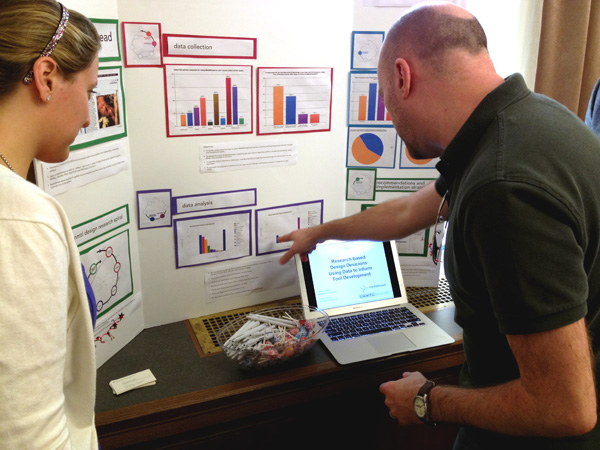
Garber and Harding used the survey results along with the observational data to make a series of recommendations for further developing Mediathread. For example, over half of student respondents said they were not provided a rubric - an explicit statement of the performance expectations and scoring guidelines for an assignment - for their Mediathread assignment. In conjunction with that finding, 1 in 5 students reported not having a clear idea of how their work would be evaluated in Mediathread.
This led Garber and Harding to discuss development beyond the code base and feature refinement, such as faculty support and training. The recommendations include establishing and describing best practices for using Mediathread as an educational tool, partnering with faculty on designing rubrics for assignments, and designing and testing assignments and exercises that would help students develop key skills for analysis and self-reflection using multimedia.
CCNMTL plans to gather longitudinal data of Mediathread over several semesters to better assess the value of Mediathread in attaining a course’s educational objectives.
Spring Release of Mediathread Includes New Look, Course Migration Feature
The Spring 2013 version of Mediathread, CCNMTL’s open-source platform for exploration, analysis, and organization of web-based multimedia content, was recently released and is now in use at Columbia University. The new version features a redesigned home page and cleaner interface, as well as a site tour for new users.
In addition, a new Course Migration feature was added that allows instructors to port all or selected assignments, compositions, items, and annotations from a previous semester’s Mediathread site into a new one.
Since launching in Fall 2010, Mediathread has been used in over 200 classes at Columbia University, helping students to analyze multimedia materials closely across a wide array of schools and departments. The platform is now also running at several other institutions, including MIT, Dartmouth, Wesleyan, Georgia Tech, and the American University in Cairo.
The code for Mediathread is freely available at https://github.com/ccnmtl/mediathread. More information, including a demo video, is available at mediathread.ccnmtl.columbia.edu. Columbia University instructors can get started with Mediathread by sending an email to ccnmtl-mediathread@columbia.edu.
CCNMTL Staff Present Mediathread at THATCamp CAA “Unconference”
This week CCNMTL’s Adrienne Garber and Mark Phillipson presented Mediathread during THATCamp CAA, an “unconference” preceding the College Art Association’s annual conference in New York City. Mediathread is CCNMTL's innovative, open-source platform for exploration, analysis, and organization of web-based multimedia content.
THATCamp (The Humanities and Technology Camp) is an open, informal meeting where humanists and technologists of all skill levels learn and build together in sessions proposed on the spot. THATCamp CAA was hosted by Columbia University and Khan Academy and took place at Macaulay Honors College of the City University of New York.
About 60 art historians, art teachers, and graduate students interested in digital art history scholarship attended the session. Garber and Phillipson described how Mediathread was used at Columbia in the undergraduate art history course “Northern Nudes from Van Eyck to Rubens.” They also demonstrated how students and scholars can bring images from ARTstor into Mediathread for annotation, study, and incorporation into essays.
The code for Mediathread is publicly available. The platform is now running at higher education institutions beyond Columbia, including MIT, The New School, Wellesley, and The American University in Cairo.
Columbia University instructors can get started with Mediathread by sending an email to ccnmtl-mediathread@columbia.edu.
New Privacy Options, Remodeled Collections In Fall Mediathread Release
A new version of Mediathread, an open-source multimedia annotation and composition tool created by the Columbia Center for New Media Teaching and Learning, was released for the Fall Semester. This release is part of continuing development of the tool, which was first released in 2010. New features for the fall include:
- A new privacy setting that allows instructors to select whether or not students in a course can see each other’s annotations.
- A remodeled “Collections” interface, including a full-collection view for easier browsing and collection management.
- An improved annotations interface that dynamically links item editing and collections and makes both available on one screen.
- In-place item and selection editing available in the composition space.
- More contextual help, indicated by blue “i” icons, with tips on using different parts of Mediathread.
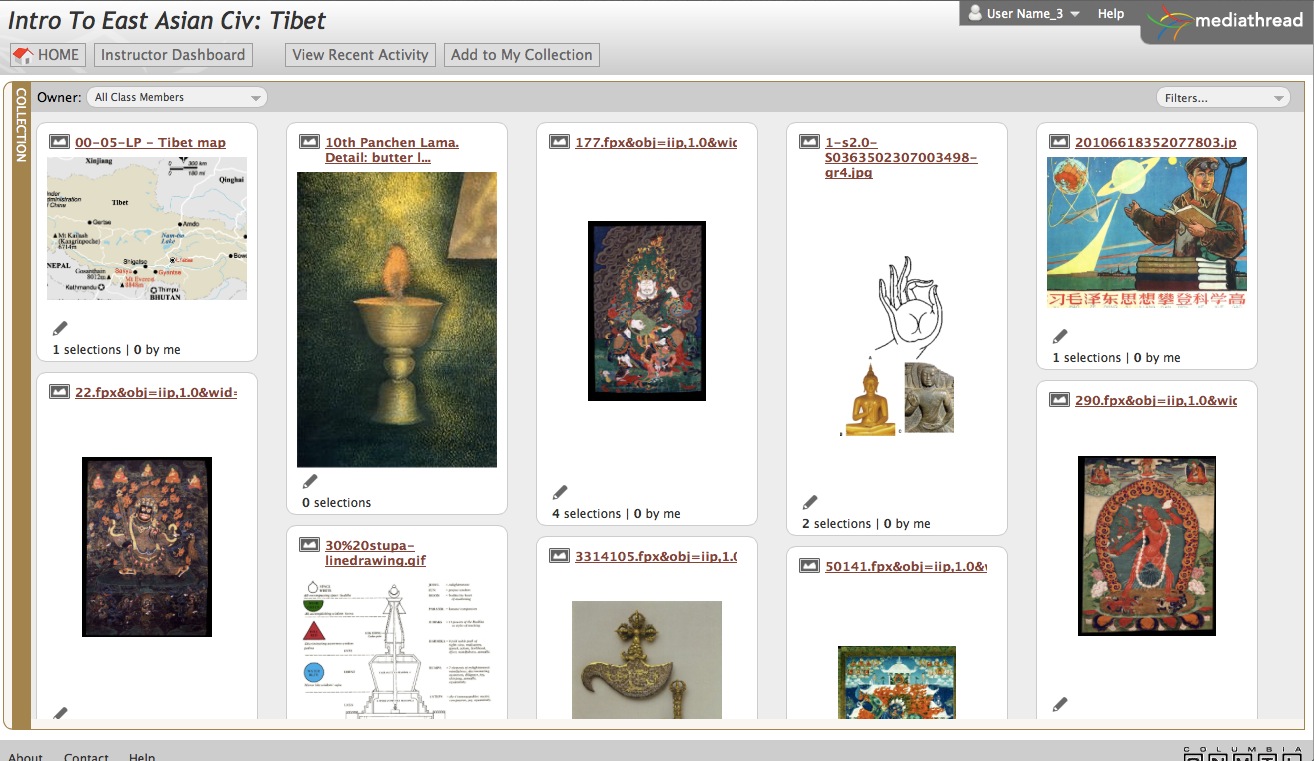
The open-source code for Mediathread is now in use at higher education institutions beyond Columbia, including MIT, The New School, Wellesley, and The American University in Cairo.
More information, including a demo video, is available at mediathread.ccnmtl.columbia.edu. Columbia University instructors can get started with Mediathread by sending an email to ccnmtl-mediathread@columbia.edu.
NMC Conference Attendees Get Hands-on with Mediathread
CCNMTL’s Jonah Bossewitch and Mark Phillipson delivered a presentation on Mediathread, the Center’s multimedia annotation tool, at the 2012 New Media Consortium (NMC) Summer Conference. Their application was accepted to be one of only a handful of hands-on workshops offered at the conference.
The NMC conference is an annual event for professionals to explore and discuss the integration of emerging technologies in teaching, learning, and creative inquiry. This year’s conference was held June 12-15 at the Massachusetts Institute of Technology.
At the workshop, Bossewitch and Phillipson demonstrated to a packed classroom how using annotation tools such as Mediathread in teaching and research can deepen analysis of rich media. Participants worked hands-on with Mediathread and learned how to embed web-based videos and images into course-based multimedia analysis.

The New Media Consortium is an international community of experts in educational technology whose goal is to help hundreds of member universities, colleges, museums, and organizations drive innovation across their campuses. One of the NMC's main initiatives is the production of annual Horizon Reports, which cover technologies that will soon have an impact on education. Copies of the higher education Horizon Report are available for viewing in the CCNMTL Faculty Support Lab in 204 Butler Library. CCNMTL has carried the NMC membership for Columbia University since 2006.
NMC is offering a collection of videos of the conference through iTunes U that includes the opening keynote by Joichi Ito, director of the MIT Media Lab, and closing remarks by Lord David Puttnam, acclaimed film producer and chancellor of Open University. The videos are also available on NMC’s YouTube channel.
New Mediathread Release Features “Sliding” Panels Interface
The Columbia Center for New Media Teaching and Learning (CCNMTL) has released a new version of Mediathread, an open-source multimedia analysis platform developed by the Center. The Summer 2012 release features “sliding” panels that allow students and instructors to more easily access different sections of the site when creating and responding to assignments.
Mediathread connects to web-based image and video collections (such as YouTube, Flickr, library databases, and course libraries), enabling users to lift items out of these collections and into an analysis environment. Multimedia items can then be clipped, annotated, organized, and embedded into essays and other written analysis.
In the new interface, assignments, responses, and feedback - as well as media embedded into any of these three content types - are organized into panels that users can open and close as needed. Students responding to an assignment posted by an instructor can now reference the assignment and embedded media while composing a response. Instructors, in turn, are able to see both the original assignment and a student’s responding composition when posting feedback.
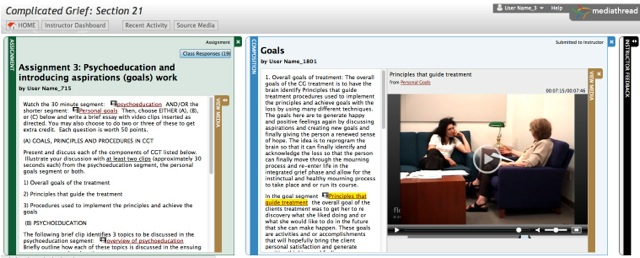
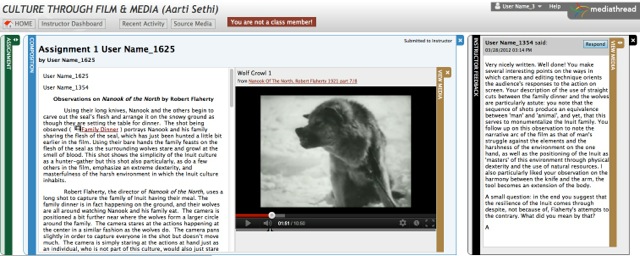
Other user interface improvements in the Summer 2012 release include redesign of the display of video and image selections within discussion boards.
The code for Mediathread is publicly available. The platform is now running at higher education institutions beyond Columbia, including MIT, The New School, Wellesley, and The American University in Cairo.
Columbia University instructors can get started with Mediathread by sending an email to ccnmtl-mediathread@columbia.edu.



